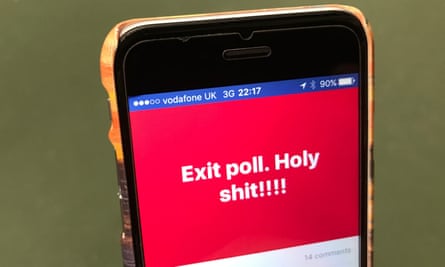The artist Cornelia Parker has, over her career, crushed a collection of silver artefacts with a steamroller; had the British army blow up a garden shed; wrapped Rodin’s The Kiss in miles of string; and collected dust and fibres from Sigmund Freud’s couch. What, then, would she make of the 2017 general election, for which she was the official artist?
She was tempted, she said in Westminster this week, to play on the idea of a hung parliament – perhaps some kind of perilously “teetering sculpture”. But in the end, she felt she could not do otherwise than represent the voices – often anxious, fearful, or angry – of the people she had encountered during her time observing the election campaign. “I was bombarded by so much emotion and visual information I had to have sound, and sensation,” she said.
The works, which go on public display in Westminster Hall from Monday, consist of two films and a series of photographs. The shorter of the two films, Election Abstract, acts as a kind of journal of Parker’s experiences, whether watching the Ukip manifesto launch, attending a pro-NHS rally or simply seeing the world around her refracted through the lens of the snap election. Many of the images had a first life on Instagram. “My iPhone has always been my sketchbook,” she said.
During the campaign she became an “unofficial member of the press pack”, attending, for example, the leader debates in Scotland and Northern Ireland. But she also simply recorded the world around her: “Everything I pointed my camera at seemed to have a political tinge – rubbish on the street, even my cat facing right or facing left,” she said. After attending the Conservative manifesto launch, for example, she wandered into a chapel in Halifax and was struck by the poignancy of an inscription reading “Remember the poor” – an image that appears in the film.
“It is a condensation of all the things that I witnessed and all the feelings I had,” she added. “And a lot of the feelings I had were provoked by the fact that there was an awful lot of distress in the country.” The frantic, speeded-up mood of the work reflects the fraught atmosphere of the campaign, bookended as it was by terrorist attacks in Manchester and London, and the Grenfell Tower disaster.

The other film, Left, Right and Centre, has a gothic, elegiac edge. Filmed in the chamber of the House of Commons at night, it shows that room, usually seen bursting with combative argument, as empty and ghostly. Newspapers, piled up on the central table and over the dispatch boxes, are gradually disturbed by the movement of a drone as it flies through the chamber. Eventually they are blown on to the benches and floor. Headlines – “May to Win by a Landslide,” for example – become briefly visible, just as soon to be replaced by, say, a Sun Page 3 model.
The 14 photographs – selected from the thousands she took from 1 May, when she started the role, to the election’s aftermath in June – are records of moods or moments. One shows a homeless man sleeping in a doorway; another a press photographer trying to look through the letterbox of Chatham House where, at the time, the Labour leader, Jeremy Corbyn, was speaking. And one pinpoints the moment of the election that many will remember above all. It is an image of a phone screen, shot at the Sunderland count at 10.17pm on the evening of 8 June. On its screen are the words: “EXIT POLL – HOLY SHIT!!!!”

Since the 2001 election, the speaker’s advisory committee on works of art, currently chaired by the Labour MP Alison McGovern, has appointed an official election artist. Parker was the first woman to take the role, following other artists including Adam Dant and Jonathan Yeo. Parker’s works will become part of the parliamentary art collection.
